How well do you know your business?
Think about it.
Who are your key partners? What are the most important activities you undertake for your business's growth and maintenance?
It’s important to stay in touch with the big picture and not get buried in the daily grind.
That’s where the business model canvas comes in.
To have one page you can reference to keep your business efforts in top form, read on.
%(tableofcontents)
What’s A Business Model Canvas?
Here's the blank template for a canvas.
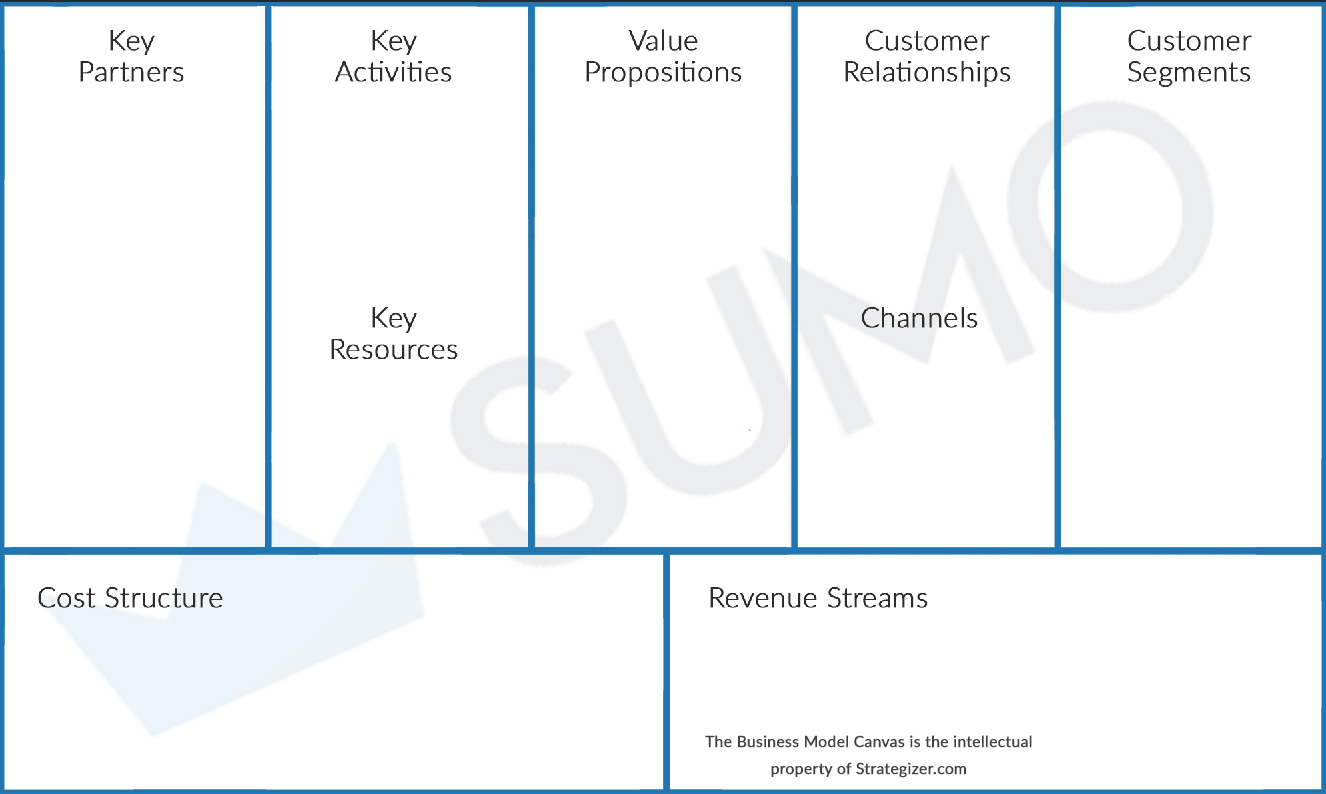
This is your one-page business plan that highlights the important aspects of your business.
Let’s talk about the advantages of using the canvas before we dive into its core elements.
Why Should You Use A Business Model Canvas?
1. It’s Easier Than A Business Plan
Business plans notoriously take a long time to write and are rarely referenced after they’re written — let’s be honest, they’re mostly written to get business loans.
It's not easy or fast to review pages and pages of text. This canvas, on the other hand, is one page, highlights the most important parts of your business and lets you strategize instead of reading.
2. It Helps You Focus On The Right Things
Whenever you feel like you don’t know what you need to do for your business, looking at your canvas is going to give you a sense of focus and help you figure out the next steps to take.
3. It's Easily Editable
Once you fill out your canvas, you can always revisit it, redo it, and come up with awesome new ideas to make a pivot in your business.
Having a printed reference can help you brainstorm the next steps you need to take, activities you need to focus on, platforms you can use to reach your customers, and many more important details.
Now that you understand why using this tool benefits your business, let’s talk about the nine elements of the business model canvas.
Nine Elements Of A Business Model Canvas
I'm going to explain to you what each canvas element is, and then give an example from a hypothetical Shopify store selling Turkish coffee.
1. Value Propositions
Value propositions are crucial in determining every other aspect of your business canvas.
What benefits do your product bring to your customers? What makes you desirable — the actual value that you propose to your customers? Why do they buy from you?
Example: For this coffee business, my two propositions are:
-
Premium Turkish coffee delivered to your door, on demand, plus a small sample of the month’s special blend.
-
A discounted monthly coffee subscription, also including the small sample of the month’s special blend.
Notice how I’ve added a small twist to my value propositions: whenever someone buys a bag of coffee from me, I send them a small sample of another blend of coffee.
I’m doing this because I want to give my customers something extra every time they order.
Here’s what this looks like on my canvas:

2. Customer Segments
Here you define the segments of customers you target. You don’t have to list every possible segment, but make sure you cover where you expect to get 85-90% of your business.
Example: I want my main customers to be people who really dig coffee. My value proposition is good coffee delivered to your door — defining my customers based on this proposition allows me to be more effective when selling to my customers.
People who care about the quality of their coffee are likely to spend more to get what I offer with my value proposition.
Of course, I’m also targeting regular coffee drinkers who want the convenience of monthly delivery.

3. Customer Relationships
After defining your customer segments, think about your relationship with them.
What tone works best for you to deliver your value proposition to your customer segments? Are your relationships one-time transactions, or long-term?
Anything you do to maintain your relationship with your customers goes here. If you want to automate your email marketing to keep fostering your relationship with your customers, that goes here. If you offer 24/7 customer service to increase customer satisfaction, that also goes here.
You might not want close relationships with your customers; you might want them to buy what they need and go to their next online activity. The relationship here could be fostering independence, and in later sections of the canvas you'll list help pages and FAQs as ways to achieve this.
Example: I want to maintain a conversational, coffeeshop-like tone and have a casual vibe throughout the business. I want to write personal copy in the content that I produce to nurture that up-close, personal feeling. I want to establish a friendly brand name, rather than a corporate, professional one like Starbucks. I believe that this is what my audience wants — a more personal experience.
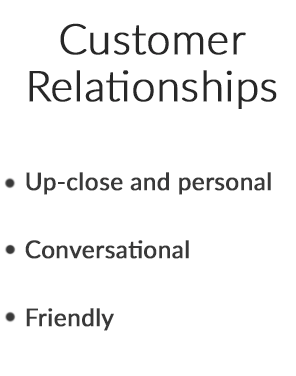
To download a printable version of the business model canvas template that I use in this article, click the button below.
Get The Business Model Canvas Template
4. Channels
You now know who your customers are. You know the value you bring them. And you know what kind of relationship you want to build with them.
The thing is, how? And where?
This is where you define your channels for finding your customers, your sales and distribution channels, and getting in touch with your customers.
Where do your customers hang out? What are some ways you can reach them to deliver them your value proposition?
Example: I want to reach out to blogs and influencers who are into coffee and specialty foods, and use them to promote my content about high-end coffee. Since I’m selling premium Turkish coffee, their audiences are more likely to buy my coffee.
I also want to write content about coffee. Again, enthusiasts are likely to read content about coffee, and then I can offer them a sample of my coffee to get them hooked.
To distribute my content more widely, I can use an email collection software, like Sumo, to get email signups. I can promise a free sample in exchange for website visitors emails.
Instagram is also a great place to share content with coffee enthusiasts. I can share interesting photos of coffee there, and occasionally promote my own coffee.
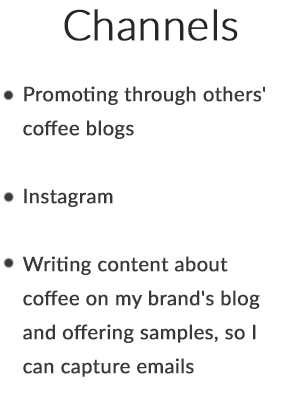
5. Key Activities
Review your value proposition and consider what are the most important activities for you to deliver your value proposition to your customer?
This is where you write down actionable activities. Activities you can do that are important for your business to thrive. Product sourcing, content production, referral programs, and product repair might go here.
Example: This section is essentially the past four sections turned into actionable activities.
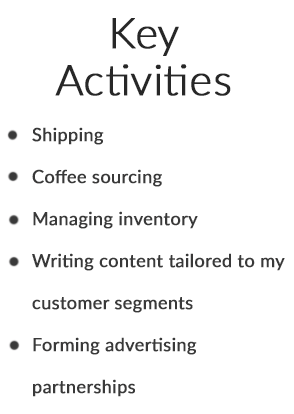
6. Key Resources
Key resources are the ingredients you need to deliver your value proposition to your customers.
If you’re a software company, that might be your developers and your support team. If you have an online store that sells jewelry, a small photo studio, beading supplies, gift boxes, and Sumo might be your key resources.
Example: I obviously need a supplier for premium Turkish coffee. That’s my main product. Then I need to be able to find new blends of coffee every month to offer my customers as samples. I also need an ecommerce store that accepts monthly payments, and I need to reliably ship my coffee to my customers.
Everything you need to do your key activities should be in your key resources.
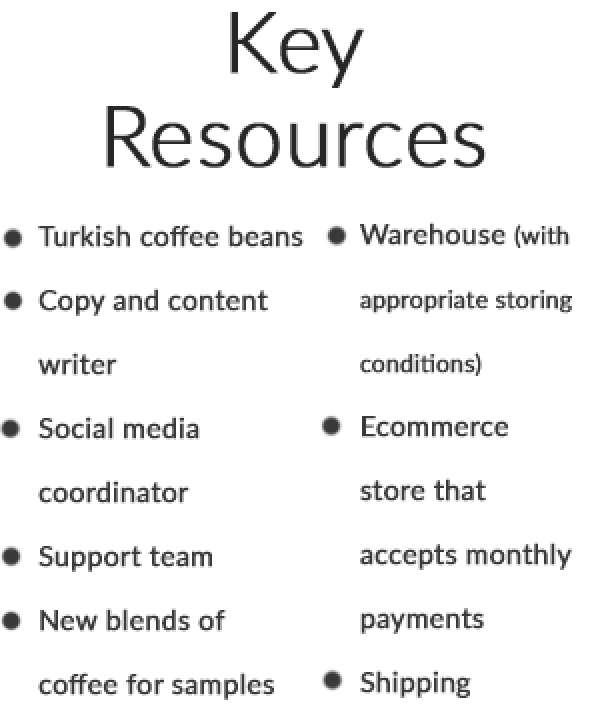
7. Key Partners
Any partnership that might be vital to your business's success goes here. Who supplies your raw materials or who manufactures the products you sell?
The distinction between resources and partners is that you need resources to be able to produce your goods or services, while you rely on partners to conduct your business.
Can you create a mutually beneficial relationship with these partners? Should some partnerships be replaced? These are some questions you should ask yourself after defining your partners.
Example: My most important partner is obviously my Turkish coffee supplier. I want to keep that relationship healthy.
Since I also want to promote my coffee through bloggers, I also want to partner with them and maintain a decent relationship.
Shipping is also a crucial aspect of my business since I rely on shipping companies to deliver my goods.
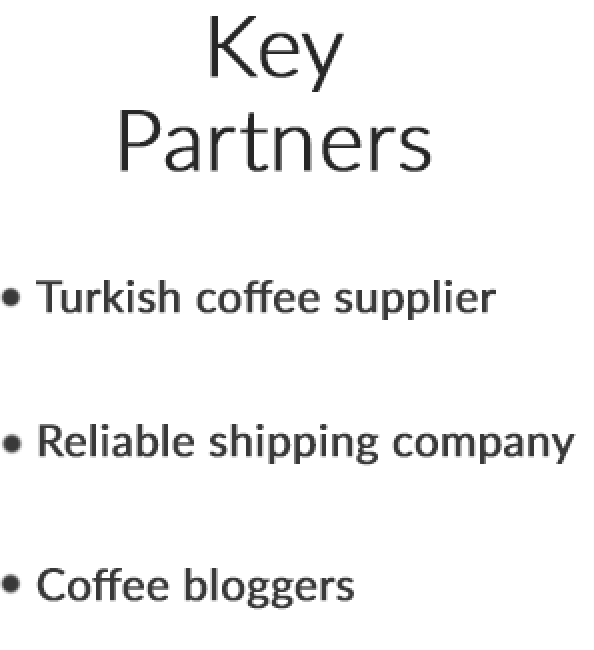
8. Cost Structure
List the important and mandatory costs of your business here.
Your Shopify subscription bill, marketing costs, raw goods, shipping costs, and facility rentals are all examples. Many of your costs will be based on your key resources, activities, and partnerships sections.
Example:
Pretty simple here. I don’t have anything else that would require me to pay anything unless I hire people to do content, social media, and support.
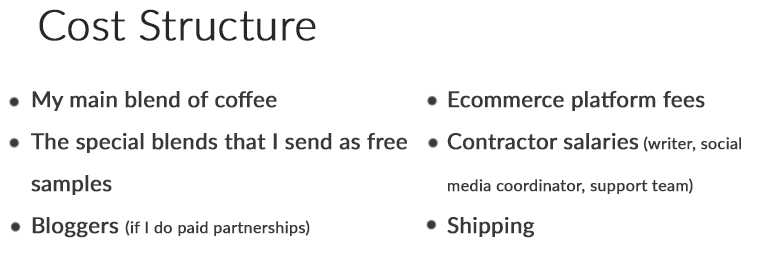
9. Revenue Streams
How does your business earn money? How do customers pay you? How much are they willing to pay you?
Subscriptions, one-time sales, licensing, courses, goods — all are possible revenue streams.
Don't worry if it's a “duh” answer!
Example: My audience pays me for the convenience of getting premium Turkish coffee delivered to their doors.
I believe that the majority of my revenue will be from monthly subscriptions.
I want to focus on the monthly subscriptions because I want to keep having a relationship with my existing customers. Finding new customers is always harder than retaining old ones. The subscription model works perfectly for this.
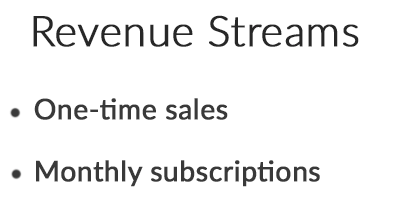
You now know all nine elements of the business model canvas.
Here’s what our final canvas looks like:
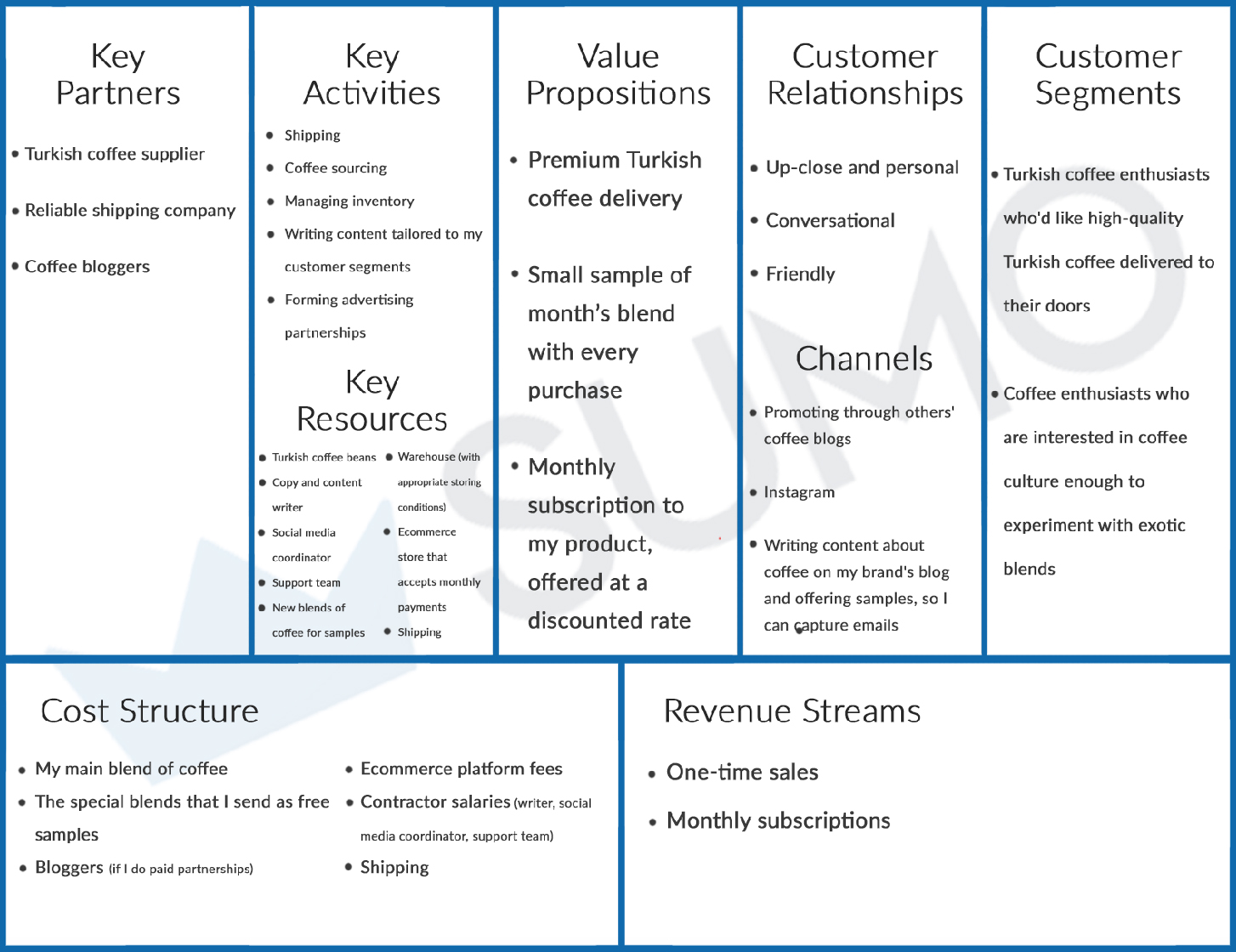
What To Do From Here?
Give the business model canvas a try. It will take just a few minutes to fill out, and it’s going to be very useful in planning your business.
Get the template I used in the article by clicking the button below. You’ll have your canvas sketched up in minutes.
Add A Comment
VIEW THE COMMENTS